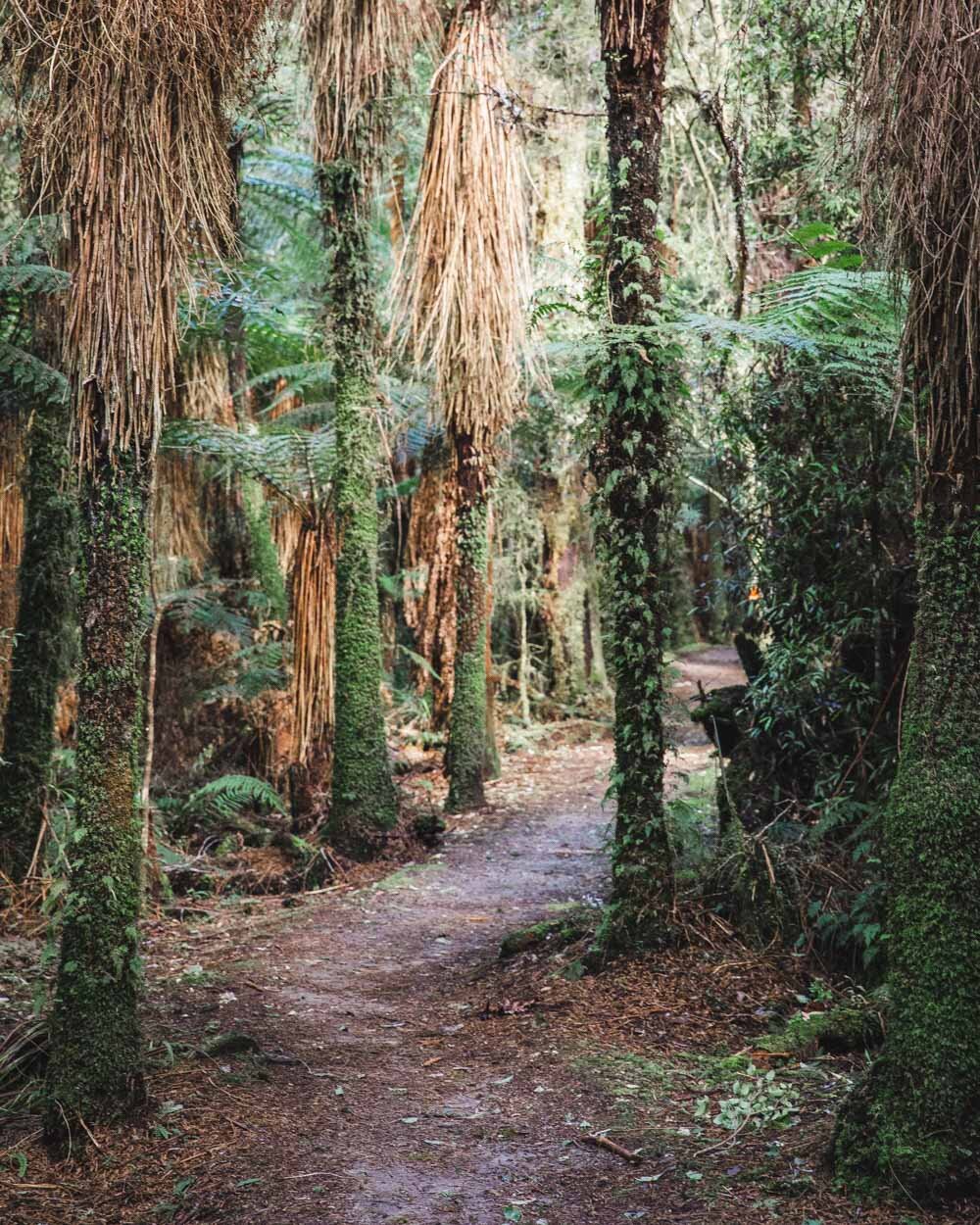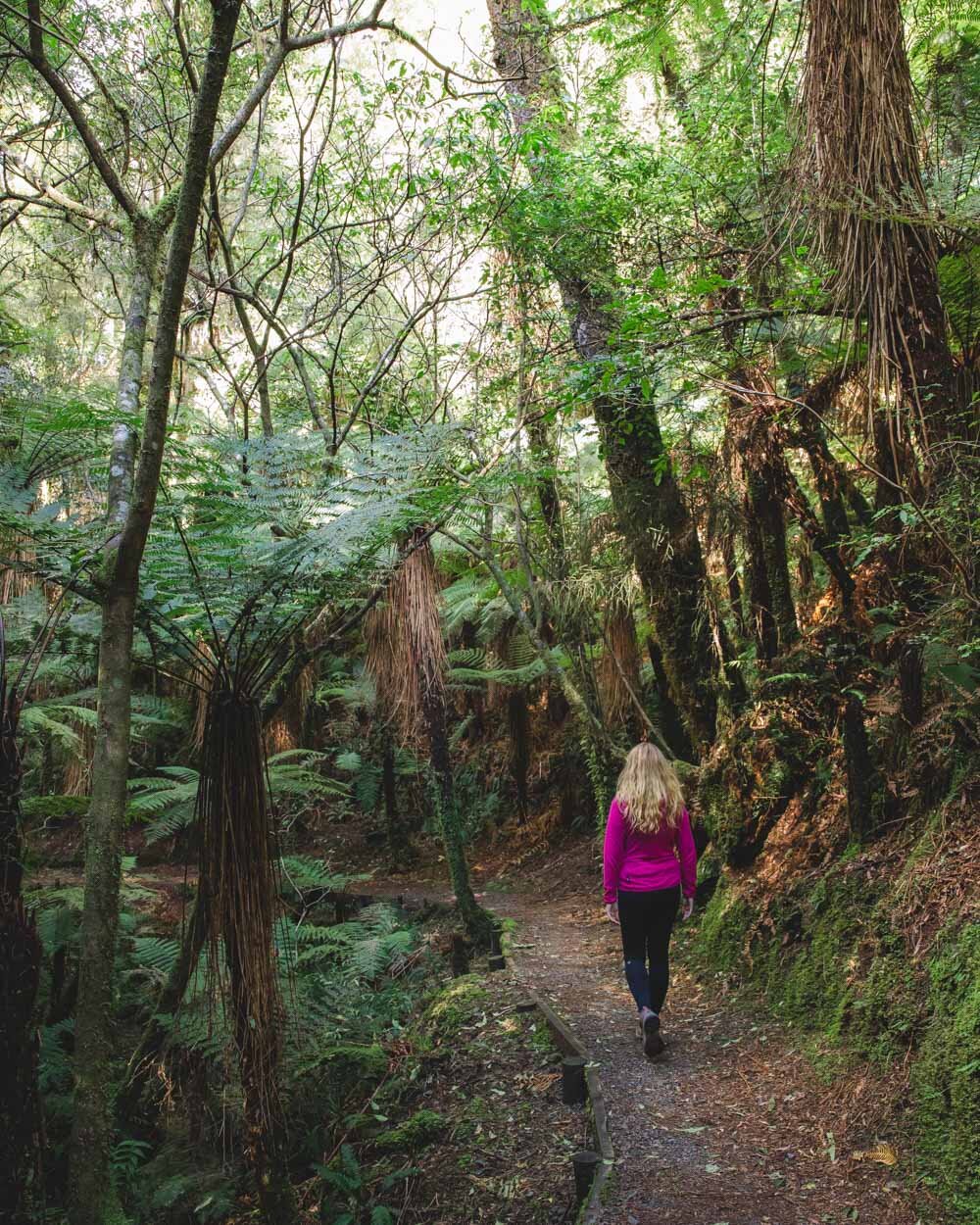Setting foot in Whirinaki Te Pua-a-Tāne Conservation Park - Whirinaki Forest - is to follow in the footsteps of dinosaurs. The beauty and majesty of this 200 million year old forest can be felt as much as seen, with a definite aura of peace and serenity. It contains some of the biggest trees in all of New Zealand and walking under the incredible forest canopy is almost a meditative experience.
As well as the breathtaking forest, there are also multiple waterfalls and an absolutely spectacular moss covered canyon. There are a number of different hiking and cycling trails on offer, we chose to walk the Whirinaki Waterfall Loop Track, a great introduction to the mighty Whirinaki Forest.
If you don’t want to walk the whole trail, skip through the trails notes to the last section on the canyon, which is a must see for anyone visiting Whirinaki.
Whirinaki Waterfall Loop Track
The stats
Distance: 10.7 km loop
Elevation gained: 200m
Difficulty: Easy
The Whirinaki Waterfall Loop Track is an easy trail, there are a few ups and downs but no steep climbs. The path is generally in very good condition, with little in the way of mud, despite the fact we were visiting during a wet spell in winter.
There are a couple of narrow sections of track and one slightly awkward tree down over the path, but it may well be removed in time. It took us 2 hours 40 minutes to do the whole loop, but that also includes time taking in the forest and waterfalls (we stopped the timer when in the canyon).
Starting the trail
The forest is beautiful from the moment you set foot on the trail, in fact from the moment you step out the car, as the car park is also surrounded by ancient giants.
The path is well maintained and smooth, with barely a tree root to cause you to have to look away from the amazing forest canopy. You’ll quickly see some kahikatea or white pine - the tallest native trees in New Zealand - as well as a whole array of the podocarps that this forest is famous for.
The forest is so quiet, but for the sounds of the birds and the river (further up the trail), if you close your eyes you could easily be listening to a nature sounds video on Youtube.
After 900m easy walking you’ll reach a junction and though you could walk in either direction, we’d recommend following the loop right first of all (this means you end the walk with the canyon which is a real highlight).
Following the river
The trail continues through the forest, in-between a sea of tree ferns, and after 400m comes out at a gorgeous waterfall.
We might have got lucky with the recent rain but it had great flow and a really lovely feel to it, almost like a little fairy grotto. It’s such a pretty spot, yet from what we can tell It doesn’t even have a name!
The trail continues alongside the river and it’s good to always take a look down where the rapids are, as it’s a favourite haunt of the local whio (blue duck).
We’ve yet to spot them ourselves but we do seem to have bad luck when it comes to whio, as we’ve been to many places where people often see them but we’ve not yet managed!
It’s a gorgeous river and the sheer number of rapids adds a relaxing backdrop to the trail. You’ll quickly pass a second small waterfall which flows under the little footbridge and you’ll need to pass quickly if you don’t want to get a soaking!
After this point the trail begins to undulate but it’s never too steep.
To Whirinaki Falls
Approximately 3km into the trail you’ll reach a junction and follow signs for Whirinaki Waterfall. This part of the walk continues undulating and does have a few muddy patches, but nothing you can’t easily manoeuvre around.
The signpost suggested that the next 2km stretch would take longer than the 3km we had already hiked. We thought this meant that it would be quite steep, but it’s not, and it took just half the time the sign suggested.
The trail follows the river much of the way, and at times the path is narrow, but it’s in good condition and didn’t feel precarious. Having said that, there was one big bushy tree down over the path (which might be cleared), but currently requires care to pass, as it sits on the edge of a crumbling riverbank.
You’ll arrive at Whirinaki Falls roughly 2km after leaving the junction. Unfortunately it looks like there used to be a trail down to the falls, but it’s now fenced off so you can only view it from the footbridge along the top.
It’s still nice to see but not what I’d call a great view.
To Te Whaiti-Nui-a-Toi Canyon - Whirinaki Canyon
The trail between Whirinaki Waterfall and the canyon is just under 5km. There is a short uphill section after the waterfall, but then the rest of the track is all either flat or downhill.
There are several junctions, but it continues to be very well signposted. The flat nature of the path means that it’s incredibly relaxing. I remember thinking that I could walk through this ancient forest all day, it almost felt like meditation.
The next major landmark along the trail is the canyon itself, which you’ll reach 9.8km into the walk. You can view the canyon from the bridge that spans it, but it is slightly obscured by trees.
The very best view comes from walking down on to the canyon walls themselves, but that does require a bit of a scramble.
Te Whaiti-Nui-a-Toi Canyon
The canyon is one of the most unique that I’ve seen, with stacked columns and almost entirely covered in a thick layer of moss. It gives it an almost ethereal feel.
If you do want to get down into the canyon, the ‘path’ down is just before the bridge, but it’s easiest to see it by first going to the bridge and then retracing your steps.
It’s just a few metres back on the right hand side of the path (opposite a tree with pink triangles marking stoat boxes, although I am not sure if these are permanent).
It’s beaten down and after a few seconds looks like it comes to a dead end, but if you look down you’ll see that there is a distinct route onto the rocks below. As mentioned it is a scramble but only takes a minute.
I found it easy on the way down and slightly harder going up as you have to make one move where you need to put one leg up onto a ledge which is quite high.
The path to the canyon
The steps down to the canyon
There are several trees to hold on to, to keep yourself steady and as mentioned it only takes a minute. If you don’t like the look of it though, you can just look down on the canyon from above, which is still a good view.
Once you’re down just go carefully because the moss can be slippery, it’s very much worth it though, the canyon is extremely beautiful and it’s mesmerising to watch the water flow through.
The river running through the canyon was high and fast on our visit. I’d initially thought I might be able to go in for a dip, but there was no chance.
Maybe at other times of year it is lower and less current, but I wouldn’t recommend going in unless it looks really calm – if it ever actually is calm. It’s hard to say when it looked so wild!
Finishing the loop
From the bridge over the canyon you are just 1km from the car park, following the sign right, towards Minginui Road. The track is flat and an easy end to a stunning walk in the Whirinaki Forest.
Essential information about the Whirinaki Te Pua-a-Tāne Conservation Park
Facilities
There isn’t much in the way of facilities here so remember to pack out all your rubbish. There is a long drop toilet at the car park but you’ll need to bring your own toilet paper.
Getting there
The majority of trails start at the River Road car park, 90km from Rotorua and further than Google Maps suggests by a good 20 minutes (although in a bigger car you might be quicker). There is a substantial portion on gravel road and it does have quite a few potholes. At time of writing it was passable even in a small car but you’d want to take it slowly.
This post may contain affiliate links, meaning at no additional cost to you, that we will earn a small commission if you click through and decide to make a purchase. This helps towards the costs of running our website. Thanks for your support.

































